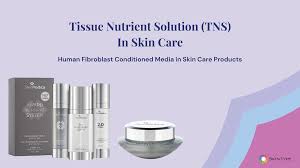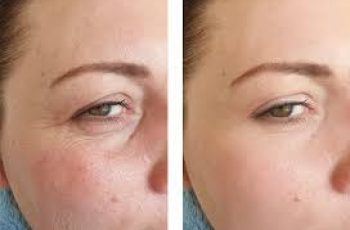
TNS in Skincare: Human Fibroblast Conditioned Media in SkinMedica Products
What is TNS in skincare?
TNS in skincare stands for Tissue Nutrient Solution. This is an antiaging ingredient with growth factors found in SkinMedica products. You will see it on skincare products labels as human fibroblast conditioned media. TNS is a proprietary blend of naturally occurring growth factors, proteins, and antioxidants that is found in SkinMedica products. Growth factors are signaling proteins that stimulate healthy cellular activity. As we age, our skin’s levels of growth factors decline. By replenishing growth factors topically, TNS in skincare products is used to recapture more youthful skin function by targeting the causes of skin aging.
This blog will explain what SkinMedica TNS is and how it works.
If you want to know if TNS is good for your skin, take our skin type quiz.
What is Human Fibroblast Conditioned Media?
A major breakthrough in antiaging skincare came when scientists began growing fibroblasts in tissue cultures. They noticed that fibroblasts naturally secrete growth factors into their surrounding growth media. Tests revealed that this conditioned media contained growth factors in large concentrations. By growing and sustaining fibroblast cultures, researchers could obtain an abundant, renewable supply of concentrated growth factors for skin rejuvenation treatments.
When SkinMedica scientists came across this fibroblast conditioned media research, they recognized its immense potential. They obtained the licenses and developed specialized processes to harvest growth factors from cultured fibroblasts. The result was TNS – a first-of-its kind blend of skin-essential growth factors, proteins and antioxidants. TNS containing antiaging products are now the top selling antiaging skincare products in the world.
Where does SkinMedica TNS Come From?
SkinMedica obtains TNS in a fascinating way. They culture neonatal fibroblasts – cells found in connective tissue – under precise conditions. These fibroblasts release bioactive substances into their growth media, including a wide array of growth factors and other beneficial proteins. SkinMedica then harvests this nutrient-rich media and purifies it to create TNS. Learn more about the history of SkinMedica and this technology here.
Is TNS Tested on Animals?
TNS and TNS-MR are not tested on animals. This technology has however been tested on humans. 🙂
What is TNS-MR?
There is a new version of TNS called TNS-MR that combines the TNS and MRCx technologies to form the most advanced growth factor serum on the market now. Dr. Gail Naughton was involved in the development of both the TNS and TNS-MR technologies. Learn more here.
How TNS and TNS-MR work
How TNS and TNS-MR work?
TNS contains a multitude of biologically active compounds that work synergistically to improve skin health. Key components include:
Growth Factors: TNS contains over 380 different growth factors, including transforming growth factor beta (TGF-β), epidermal growth factors (EGF), fibroblast growth factors (FGF), and others. These stimulate cellular proliferation and activity to improve skin structure and function.
Matrix Proteins: Matrix proteins like collagen help reinforce the skin’s support structure. TNS provides soluble collagen that skin cells readily incorporate.
Antioxidants and anti-inflammatories: TNS contains antioxidants and anti-inflammatory agents that combat skin damage from UV rays, pollution, and other environmental factors.
Overall, TNS aims to shift skin cells into a more youthful state, both functionally and aesthetically. Let’s look at some key studies on TNS products.
Skincare Products with Human Fibroblast Conditioned Media
SkinMedica is the only brand that contains TNS although itis possible that other brand contin extracts of human fibroblast conditioned media. I do not know of any other brands currently on the market. Only SkinMedica has TNS and TNS-MR in it’s products.
Skincare Products with TNS
This was the first TNS product that SkinMedica launched in 2001. It has a strange smell due to proteins in it that have been removed in the more recent product formulations also has many fragrances added that can cause a skin allergy. Good for dry, oily, and sensitive skin types. that are not allergic to fragrance.
This heavy facial moisturizer contains TNS in addition to ceramides, peptides, Vitamin C, and squalane. It has retinyl palmitate so always use it under a sunscreen. This is not a true barrier repair moisturizer but it can be used as an occlusive moisturizer and to “slug” other serums into the skin.Best for dry skin types.
This TNS containing eye serum also has peptides and antioxidants like Vitamin E, Vitamin C and multiple oils. This eye cream has retinyl palmitate in it so always use this either at night or with a sunscreen.
Skincare Products with TNS-MR
SkinMedica TNS Advanced + Serum is the latest and most advanced of the SkinMedica antiaging serums. This is my favorite of the SkinMedica Antiwrinkle Serums. In addition to TNS-MR, it has several peptides. It also has Lactococcus Ferment Lysate and Saccharide Isomerate which may stabilize the skin microbiome.
Studies have shown (21) that this SkinMedica antiaging serum is good for menopausal skin.
Research studies on Tissue Nutrient Solution in Skincare
Several studies demonstrate that TNS-containing products can improve signs of facial aging. Topical growth factors found in tissue nutrient solution (TNS) have been clinically evaluated for improving photodamaged skin in several studies. An early open-label study on TNS Recovery Complex (containing conditioned media NouriCel-MD) applied twice daily for 60 days in 14 subjects with facial photodamage showed histological evidence of new collagen formation in the dermis and epidermal thickening (1,3). A larger double-blind, randomized study on 60 subjects using the same TNS serum for 6 months resulted in significant improvement in clinical grading of fine lines and wrinkles at 3 months and optical profilometry showed reduced skin surface roughness compared to vehicle (10).
A recent double-blind, placebo-controlled study assessed the effects of a novel topical growth factor-based serum (A+) targeting multiple biological mechanisms underlying intrinsic and extrinsic skin aging (17) Preclinical studies showed A+ reduced expression of cellular senescence biomarkers. Additional gene analysis in human skin models demonstrated effects on pathways related to stem cell exhaustion and intercellular communication. The 24-week clinical study enrolled 68 subjects with moderate-to-severe facial photodamage randomized to A+ or vehicle placebo. A+ provided significant improvements compared to placebo in coarse wrinkles, fine wrinkles, overall photodamage, sagging, skin tone evenness, and hyperpigmentation. During the crossover period where placebo subjects switched to A+, similar significant results were achieved. Subjects also perceived looking up to 6 years younger. Facial biopsy analysis showed reduced H2A.J expression and improved dermal extracellular matrix and epidermal barrier components in the A+ group. Overall this data demonstrates for the first time that targeting biological mechanisms including cellular senescence enables true anti-aging skincare to inhibit skin aging processes and effectively improve multiple signs of intrinsic and extrinsic aging.
Overall the results demonstrate that regular use of TNS-containing topical serums reduces visible signs of photodamage and skin aging, likely due to the wide array of active biomolecules that stimulate skin regeneration through numerous mechanisms, including extracellular matrix remodeling, epidermal repair, and antioxidant and anti-inflammatory activity. Further studies should assess the potential long-term effects and evaluate efficacy in subjects of differing ethnicities. Nevertheless, current evidence supports TNS as an effective therapeutic option for treatment of photodamaged and aging skin.
In 2022 a 12-week open-label study by Gold (21) assessed TNS Advanced+ for treating moderate-to-severe facial photodamage in 15 postmenopausal women. Twice-daily use of TNS Advanced+ led to significant improvements in fine lines/wrinkles, coarse lines/wrinkles, overall photodamage, skin tone evenness, and tactile roughness at 6 and 12 weeks compared to baseline. Subject self-assessments showed agreement that TNS Advanced+ improved skin smoothness, softness, radiance, and rejuvenation. The growth factor serum was well-tolerated. Overall, the results demonstrate that targeting processes underlying intrinsic and extrinsic skin aging with topical growth factors can effectively improve multiple signs of facial photodamage even in aged postmenopausal skin.
Is TNS safe in skin care
Is TNS Safe in Skincare?
The safety of human fibroblast conditioned media has not been established in any long term studies. However, it was used for years in the injectbale fillr Cosmederm and CosmeoPlast and no long term issues were seen. Those fillers underwent FDA safety trails. They are no longer available because longer lasting hyaluronic acid fillers are now preferred -but there were no safety issues that I know of.
TNS has been used for over 20 years without any evidence of an increase in skin cancer.
TNS should be safe unless you have a history of skin cancer or excess sun exposure. There are some doubts about the safety of EGF which is one of the growth factors in this serum, but there are many growth factors besides EGF in SkinMedica products and thousands of people have used TNS without reports of any increase in skin cancer (that I know of). A class action lawsuit against SkinMedica for not clearly stating risks was abandoned in 2018. (18)
So is it safe- probably. ALWAYS tell your dermatologist if you see any growing or changing moles anywhere on your skin.
Wondering if TNS is right for you? It all depends on your skin type.
Most skin types can tolerate TNS. It should be used in an antiaging skincare routine. Results should be even better when combined with Vitamin C and retinoids. Want to know the difference between TNS, stem cells and exosomes? Click here.
Take the quiz to see how to use TNS in your skincare routine.


